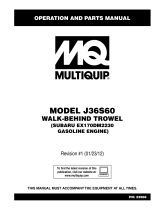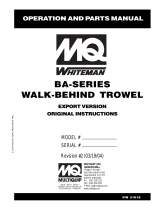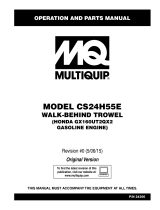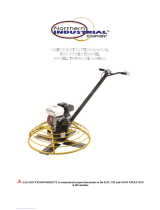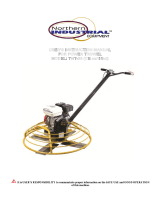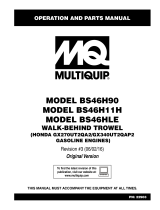Page is loading ...

OPERATION MANUAL
P/N 21768
KOHLER 27 HP
KOHLER 28 HP EFI
SERIES
MODEL CA4HCMODEL CA4HC
MODEL CA4HCMODEL CA4HC
MODEL CA4HC
WALK-BEHIND TROWEL
(HONDA GASOLINE ENGINE)
Revision #0 (09/29/06)
THIS MANUAL MUST ACCOMPANY
THE EQUIPMENT AT ALL TIMES.
To find the latest revision of this
publication, visit our website at:
www.multiquip.com


Grinding/cutting/drilling of masonry, concrete, metal and
other materials with silica in their composition may give
off dust or mists containing crystalline silica. Silica is a
basic component of sand, quartz, brick clay, granite and
numerous other minerals and rocks. Repeated and/or
substantial inhalation of airborne crystalline silica can
cause serious or fatal respiratory diseases, including
silicosis. In addition, California and some other
authorities have listed respirable crystalline silica as a
substance known to cause cancer. When cutting such
materials, always follow the respiratory precautions
mentioned above.
WARNING
Grinding/cutting/drilling of masonry, concrete, metal and
other materials can generate dust, mists and fumes
containing chemicals known to cause serious or fatal
injury or illness, such as respiratory disease, cancer,
birth defects or other reproductive harm. If you are
unfamiliar with the risks associated with the particular
process and/or material being cut or the composition of
the tool being used, review the material safety data
sheet and/or consult your employer, the material
manufacturer/supplier, governmental agencies such as
OSHA and NIOSH and other sources on hazardous
materials. California and some other authorities, for
instance, have published lists of substances known to
cause cancer, reproductive toxicity, or other harmful
effects.
Control dust, mist and fumes at the source where
possible. In this regard use good work practices and
follow the recommendations of the manufacturers or
suppliers, OSHA/NIOSH, and occupational and trade
associations. Water should be used for dust
suppression when wet cutting is feasible. When the
hazards from inhalation of dust, mists and fumes cannot
be eliminated, the operator and any bystanders should
always wear a respirator approved by NIOSH/MSHA for
the materials being used.
WARNING
SILICOSIS WARNING RESPIRATORY HAZARDS

PAGE 4 — CA4HC WALK-BEHIND TROWEL— OPERATION MANUAL — REV. #0 (09/29/06)
CA4HC TROWEL— TABLE OF CONTENTS
Specifications and
part numbers are
subject to change
without notice.
NOTE
MQ WHITEMAN CA4HC
WALK-BEHIND TROWEL
Table Of Contents ..................................................... 4
Dimensions ............................................................... 5
Specifications ............................................................ 6
Training Checklist ...................................................... 8
Daily Pre-Operation Checklist ................................... 9
Safety Message Alert Symbols .......................... 10-11
Rules For Safe Operation .................................. 12-13
Operation And Safety Decals .................................. 14
General Information ................................................ 15
Controls and Components ...................................... 16
Basic Engine ........................................................... 17
Handle Assemblies ............................................18-19
Pre-Inspection .................................................... 21-22
Initial Start-Up .................................................... 23-24
Operation ........................................................... 25-26
Options .................................................................... 26
Maintenance ...................................................... 27-30
Troubleshooting (Trowel) ........................................ 31
Troubleshooting (Engine) ........................................ 32
Terms and Condition Of Sale .................................. 35

CA4HC WALK-BEHIND TROWEL — OPERATION MANUAL — REV. #0 (09/29/06) — PAGE 5
CA4HC TROWEL— DIMENSIONS
Figure 1. CA4HC Trowel Dimensions
thgieW&snoisnemiDleworTMH4-4AC.1elbaT
)elaBgnitfiL(thgieH-A).ni0.82(mm117
)reveLtnemegagnE(thgieH-B).ni52.63(mm129
htdiW-C).ni42(mm016
htgneL-D).tf80.5(m55.1
thgieW).sbl521(gk75
D
A
B
C

PAGE 6 — CA4HC WALK-BEHIND TROWEL— OPERATION MANUAL — REV. #0 (09/29/06)
CA4HC TROWEL— SPECIFICATIONS
2. Sound pressure is a weighted measure. It is measured at
the operator's ear position while the walk-behind trowel is
operating at full throttle on concrete in a manner most often
experienced in “
normal
” circumstances. Sound pressure
may vary depending upon the condition of the concrete.
1. The vibration level indicated is the maximum RMS (Root
Mean Square) value obtained at the handle grip while
operating the walk-behind trowel at full throttle on steel
plate with blades partially pitched.
NOTE:
snoitacificepSenignE.3elbaT
enignE
ledoM 2XQ1K021XGADNOH
epyT rednilyCelgniS,evlavdaehrevO,ekorts-4
ekortSXeroB
.ni7.1X.ni4.2
)mm24xmm06(
tnemecalpsiD)cc911(.ni.uc3.7
tuptuOxaM .M.P.R006,3ta)SP0.4,Wk9.2(.P.H9.3
yticapaCknaTleuF )sretiL5.2(snollaG.S.U66.0.xorppA
deepSeldIdradnatS .M.P.R051-/002+004,1
leuFenilosaGdedaelnU
yticapaCliOebuL )sretiL06.0(strauQ.S.U36.0
dohteMlortnoCdeepS epyTthgiew-ylFlagufirtneC
dohteMgnitratStratSlioceR
noisnemiD
)HxWxL(
.ni5.21X4.31x7.11
)mm813X143X792(
teNyrD
thgieW
).gK0.31(.sbl7.82
snoitacificepSleworTCH4AC.2elbaT
sedalBforebmuN4
retemaiDgniR ).mc16(.ni0.42
rotoR MPR031-07
htdiWhtaP ).mc16(.ni42
)mrA/dnaH(noitarbiV
1
s/m9.81
2
)dethgieW-A(erusserPdnuoS
2
)A(Bd5.38
)dethgieW-C,kaeP(erusserPdnuoS )C(Bd5.09
)dethgieW-A(leveLrewoPdnuoS )A(Bd79

CA4HC WALK-BEHIND TROWEL — OPERATION MANUAL — REV. #0 (09/29/06) — PAGE 7
NOTE PAGE

PAGE 8 — CA4HC WALK-BEHIND TROWEL— OPERATION MANUAL — REV. #0 (09/29/06)
TRAINING CHECKLIST
This checklist will lists some of the minimum requirements for
machine maintenance and operation. Please feel free to detach
it and make copies. Use this checklist whenever a new operator
is to be trained or it can be used as a review for more experienced
operator’s.
Operator _________________________________________ Trainee __________________________________________
COMMENTS:
CA4HC TROWEL— TRAINING CHECKLIST
TSILKCEHCGNINIART
.ON NOITPIRCSED ?KO ETAD
1 .yletelpmoclaunaMs’rotarepOdaeR
2
dnaenignefognikcehc,stnenopmocfonoitacol,tuoyalenihcaM
.leveldiulfxobraeg
3 .erudecorpgnileufer,metsysleuF
4 .)gninnurtonenihcam(slortnocfonoitarepO
5 .slortnocytefaS
6 .serudecorppotsycnegremE
7 .enihcamfoputratS
8 .gnirevuenaM
9 .gnihctiP
01 .seuqinhcetgnihsinifetercnoC
11 .enihcamfonwodtuhS
21 .enihcamfognitfiL
31 .egarotsdnatropsnartenihcaM

CA4HC WALK-BEHIND TROWEL — OPERATION MANUAL — REV. #0 (09/29/06) — PAGE 9
DAILY PRE-OPERATION CHECKLIST
COMMENTS:
CA4HC TROWEL— DAILY PRE-OPERATION CHECKLIST
TSILKCEHCNOITAREPO-ERPYLIAD
1
.leveLliOenignE
2
diulFxobraeGleveL
.
3
sedalBfonoitidnoC
.
4
.noitarepOhctiPedalB

PAGE 10 — CA4HC WALK-BEHIND TROWEL— OPERATION MANUAL — REV. #0 (09/29/06)
CA4HC TROWEL— SAFETY MESSAGE ALERT SYMBOLS
Safety precautions should be followed at all times when operating
this equipment. Failure to read and understand and comply with
the Safety Messages and Operating Instructions could result in
injury to yourself and others.
FOR YOUR SAFETY AND THE SAFETY OF OTHERS!
This Owner's Manual has been developed to provide complete
instructions for the safe and
efficient operation of the MQ
Whiteman CA4HC TROWEL.
For engine maintenance
information, please refer to the
engine manufacturer's
instructions for data relative to its
safe operation.
Before using this WALK-BEHIND TROWEL, ensure that the
operating individual has read, understands, and complies
with all instructions in this manual.
HAZARD SYMBOLS
Engine exhaust gases contain poisonous
carbon monoxide. This gas is colorless and
odorless, and can cause death if inhaled.
NEVER operate this equipment in a confined
area or enclosed structure that does not
provide ample free flow air.
Gasoline is extremely flammable, and its
vapors can cause an explosion if ignited. DO
NOT start the engine near spilled fuel or
combustible fluids. DO NOT fill the fuel tank
while the engine is running or hot. DO NOT
overfill tank, since spilled fuel could ignite if it
comes into contact with hot engine parts or
sparks from the ignition system. Store fuel in
approved containers, in well-ventilated areas
and away from sparks and flames. NEVER
use fuel as a cleaning agent.
Burn Hazards
Engine components can generate extreme heat.
To prevent burns, DO NOT touch these areas
while the engine is running or immediately after
operations. NEVER operate the engine with
heat shields or heat guards removed.
Guards and Entanglement Hazards
NEVER operate equipment with covers, or
guards removed. Keep
fingers, hands
,
hair
and
clothing
away from all moving parts to
prevent injury.
Explosive Fuel
Lethal Exhaust Gases
NOTE
SAFETY MESSAGE ALERT SYMBOLS
The three (3) Safety Messages shown below will inform you
about potential hazards that could injure you or others. The
Safety Messages specifically address the level of exposure to
the operator, and are preceded by one of three words: DANGER,
WARNING, or CAUTION.
You WILL be
KILLED
or
SERIOUSLY INJURED
if you DO NOT follow these directions.
You CAN be KILLED or
SERIOUSLY INJURED
if
you DO NOT follow these directions.
You CAN be
INJURED
if you DO NOT follow
these directions.
CAUTICAUTI
CAUTICAUTI
CAUTION
DANGERDANGER
DANGERDANGER
DANGER
WARNINGWARNING
WARNINGWARNING
WARNING
Potential hazards associated with trowel operation will be
referenced with Hazard Symbols which appear throughout this
manual, and will be referenced in conjunction with Safety
Message Alert Symbols.
Rotating Blades Hazards
NEVER place hands or feet inside the guard
rings while the engine is running.

CA4HC WALK-BEHIND TROWEL — OPERATION MANUAL — REV. #0 (09/29/06) — PAGE 11
Accidental Starting
ALWAYS place the engine ON/OFF
switch in the OFF position, when the
trowel is not in use.
Over Speed Conditions
NEVER tamper with the factory settings of the
engine governor or settings. Personal injury
and damage to the engine or equipment can
result if operating in speed ranges above
maximum allowable.
Respiratory Hazard
ALWAYS wear approved respiratory protection.
ALWAYS wear approved eye and hearing
protection.
Sight and Hearing hazard
Equipment Damage Messages
Other important messages are provided throughout this manual
to help prevent damage to your trowel, other property, or the
surrounding environment.
CA4HC TROWEL— SAFETY MESSAGE ALERT SYMBOLS
This walk-behind trowel, other property, or the
surrounding environment could be damaged
if you do not follow instructions.
CAUTICAUTI
CAUTICAUTI
CAUTION

PAGE 12 — CA4HC WALK-BEHIND TROWEL— OPERATION MANUAL — REV. #0 (09/29/06)
CA4HC TROWEL — RULES FOR SAFE OPERATION
The following safety guidelines should always be used when
operating the CA4HC.
SAFETY
■
DO NOT operate or service this equipment
before reading this entire manual. The
manual must be kept available and accessible
to the operator.
■
This equipment should not be operated by persons under the
minimum statutory age limit.
■
ALWAYS use extreme caution when working with flammable
liquids. When refueling, STOP the engine and allow it to cool.
■
NEVER touch the hot exhaust manifold, muffler
or cylinder. Allow these parts to cool before
servicing the trowel.
■
The engine of this trowel requires an adequate free flow of
cooling air. NEVER operate the trowel in any enclosed or
narrow area where free flow
of the air is restricted. If the
air flow is restricted it will
cause serious damage to
the engine and may cause
injury to people. Remember
the engine gives off
DEADLY
carbon monoxide
gas.
■
High Temperatures – Allow the engine to cool before adding
fuel or performing service and maintenance functions. Contact
with
hot!
components can cause serious burns.
■
ALWAYS refuel in a well-ventilated area, away from sparks
and open flames.
RULES FOR SAFE OPERATION
■
ALWAYS check the trowel for loosened hardware such as
nuts and bolts before starting.
■
Replace nameplate, operation and safety decals when they
become difficult to read.
■
NEVER use accessories or attachments which are not
recommended by Multiquip for this equipment. Damage to
the equipment and/or injury to user may result.
■
Manufacturer does not assume responsibility for any accident
due to equipment modifications. Unauthorized equipment
modification will void all warranties. Any modification which
could lead to a change in the original characteristics of the
machine should be made only by the manufacturer who shall
confirm that the machine is in conformity with appropriate
safety regulations.
WARNINGWARNING
WARNINGWARNING
WARNING
Failure to follow instructions in this manual may lead to serious
injury or even death! This equipment is to be operated by
trained and qualified personnel only! This equipment is for
industrial use only.
■
NEVER
smoke
around or near the machine.
Fire or explosion could result from
fuel
vapors
, or if fuel is spilled on a
hot!
engine.
■
Topping-off to filler port is dangerous, as it tends to spill fuel.
■
NEVER use fuel as a cleaning agent.
■
NEVER operate this equipment when not feeling well due to
fatigue, illness or taking medicine.
■
NEVER operate the trowel under the influence or drugs or
alcohol.
■
NEVER operate the trowel without proper protective clothing,
shatterproof glasses, steel-toed boots and other protective
devices required for the job.
■
NEVER use this machine for any purpose other than those
described in this manual.
■
NEVER operate the trowel in an
explosive atmosphere where fumes
are present, or near combustible
materials. An explosion or fire could
result in severe
bodily harm or even
death.

CA4HC WALK-BEHIND TROWEL — OPERATION MANUAL — REV. #0 (09/29/06) — PAGE 13
■
NEVER Run engine without air filter. Severe engine damage
may occur. Service air filter frequently to prevent carburetor
malfunction.
■
NEVER place your
feet
or
hands
inside the guard rings
while starting or operating this equipment.
■
AVOID wearing jewelry or loose fitting clothing that may snag
on the controls or moving parts as this can cause a serious
injury.
■
ALWAYS keep clear of
rotating
or
moving parts
while
operating the trowel.
■
Moving Parts – Shut down the engine before performing
service or maintenance functions. Contact with moving parts
can cause serious injury.
■
ALWAYS check to make sure that the operating area is clear
before starting the engine.
■
NEVER leave the machine
unattended
while running.
■
ALWAYS be sure the operator is familiar with proper safety
precautions and operations techniques before using trowel.
■
ALWAYS keep the work area well organized.
■
ALWAYS clear the work area of any debris, tools, etc. that
would constitute a hazard while the trowel is in operation.
■
ALWAYS know the location of
the nearest
fire extinguisher
.
CA4HC TROWEL — RULES FOR SAFE OPERATION
■
ALWAYS know the location of the
nearest
first aid kit
.
■
In emergencies
always
know the location of the
nearest phone or
keep a phone on the job site
.
Also know the phone numbers of the nearest
ambulance
,
doctor
and
fire department
. This
information is invaluable in the case of an
emergency and could keep a serious situation from
becoming a tragic one .
■
NEVER lubricate components or attempt service on a running
trowel.
■
ALWAYS allow the trowel a proper amount of time to cool
before servicing.
■
Keep the trowel in proper running condition.
■
Fix damage to the trowel immediately and always replace
broken parts.
■
Dispose of hazardous waste properly. Examples of potentially
hazardous waste are used motor oil, fuel and fuel filters.
■
DO NOT use food or plastic containers to dispose of
hazardous waste.
■
ALWAYS shutdown engine before transporting.
■
Tighten fuel tank cap securely and close fuel cock to prevent
fuel from spilling.
■
Drain fuel when transporting trowel over long distances or
bad roads.
Transporting
■
ALWAYS store equipment properly when it is not being used.
Equipment should be stored in a clean, dry location out of the
reach of children.
■
No one other than the operator is to be in the working area
when the trowel is in operation.
■
Always observe all applicable compulsory regulations
relevant to environmental protection, especially, fuel storage,
the handling of hazardous substances, and the wearing of
protective clothing and equipment. Instruct the user as
necessary, or, as the user, request this information and
training.
Emergencies
■
When placing the trowel inside a truck-bed for transport,
always tie-down the trowel.
■
ALWAYS use proper lifting techniques when moving the
trowel.
ALWAYS check to make sure that the operating area is
clear before starting the engine.
WARNINGWARNING
WARNINGWARNING
WARNING
Maintenance Safety

PAGE 14 — CA4HC WALK-BEHIND TROWEL— OPERATION MANUAL — REV. #0 (09/29/06)
CA4HC TROWEL— OPERATION AND SAFETY DECALS
OPERATION AND SAFETY DECALS
The CA4HC walk-behind trowel is equipped with a number of operation, safety and maintenance decals. Should any of these
decals become unreadable, replacements can be obtained from your dealer.
P/N 20936
P/N 2942 WHITE TEXT 13”
P
O
W
E
R
T
R
O
W
E
L
P/N 1848
P/N: 11246
P/N: 13118
P/N: 1492
(STANDARD MODEL)
P/N: 21455
P/N 35137
To avoid injury,
you MUST read
and understand
operator’s manual
before using this
machine.
Ask for training
as needed.
This machine to
be operated by
qualified
personnel only.
P/N 35137
WARNING
MODEL
SERIAL NO.
P/N 36099 (ISO Blue)
P/N 20816
Engine exhaust and some of
its constituents, and some dust created
of California to cause cancer, birth
defects and other reproductive harm.
by power sanding, sawing, grinding,
drillingandother construction activities
contains chemicals known to the State
Some examples of thesechemicals are:
Leadfromlead-based paints.
Crystallinesilicafrombricks.
Cementandother masonry products.
Arsenicandchromiumfromchemically
treatedlumber.
Your risk from these exposures varies,
dependingonhowoftenyoudothistype
of work. To reduce your exposure to
these chemicals: work in aALWAYS
well ventilated area, and work with
approved safety equipment, such as
dust masks that are specially designed
to filter out microscopic particles.
CONTACT
PARTS
DEPARTMENT
P/N 20525
P/N 21302
P/N 35168
P/N 11092
WARNING
ROTATING BLADE
HAZARD
Keep hands
and feet clear
of guard rings.
Stop engine
before servicing.
P/N 35168
P/N 35168
CHECK
GEAR DRIVE
GEAR DRIVE
CHECK
HOT
BELT DRIVE
CLOCKWISE
COUNTER
CLOCKWISE
LUBRICATION
LUBRICATION
LIFTING POINTLIFTING POINT
LUBRICATION
LUBRICATION
Figure 2. Operation and Safety Decals

CA4HC WALK-BEHIND TROWEL — OPERATION MANUAL — REV. #0 (09/29/06) — PAGE 15
CA4HC TROWEL— GENERAL INFORMATION
CA4HC Trowel Familiarization
This walk-behind trowel is designed for the
floating
and
finishing
of concrete slabs.
Take a walk around the trowel. Take notice of all the major
components (see Figure 2) like the engine, blades, Standard or
Quick Pitch™ handle, etc.
Read
all the safety instructions carefully. Safety instructions will
be found throughout this manual and on the trowel. Keep all
safety information in good, readable condition. Operators should
be well trained on the operation and maintenance of the trowel.
Before using your trowel, test it on a flat watered down section of
finished concrete that is free of any debris and other objects.
This trial test run will increase your confidence in using the trowel
and at the same time it will familiarize you with the trowel’s
controls. In addition you will understand how the trowel handles
under actual conditions.
Engine
This trowel is available with an 4 HP
HONDA gasoline engine
.
Refer to the engine owner’s manual for instructions regarding
the operation and maintenance of your engine. Please contact
your nearest Multiquip Dealer for a replacement should the
original manual disappear or otherwise become unusable.
Training
For proper training, please use the “TRAINING CHECKLIST”
located in the front of this manual (Page 8). This checklist will
provide an outline for an experienced operator to provide training
to a new operator
Blades
The blades of the trowel finish the concrete as they are rotated
around the surface. This trowel comes equipped with four
combination
(8 in./203mm wide)
blades
per rotor equally
spaced in a radial pattern and attached to vertical rotating
shaft by means of the spider assembly
.
Centrifugal Clutch
In the event of a trowel runaway condition (operator releases
the handle), a
centrifugal clutch
will stop the engine and
bring the trowel to a halt.
Drive System
Power is transferred from the engine to the gearbox input shaft
via a
V-belt pulley drive system
. The pulley engages using a
centrifugal clutch. See Parts section of this manual.
Gearbox
The
gearbox
is located beneath the engine and transfers power
to the spider assembly. The gearbox controls the rotational speed
of the trowel and is equipped with two shafts (input and output).
Guard Ring
This unit is equipped with a special rotating
guard ring
. It is
designed to allow the operator to run the machine alongside
walls, pipes, and obstructions without marring the surface.
CAUTIONCAUTION
CAUTIONCAUTION
CAUTION
NEVER attempt to
lift
the trowel by yourself. ALWAYS get
the assistance of another person to help lift the trowel .
Operate the CA4HC Trowel, tools and components in accordance
with the manufacturer's instructions. Use of any other tools for
stated operation is considered contrary to designated use. The
risk of such use lies entirely with the user. The manufacturer
cannot be held liable for damages as a result of misuse.
Intended Use
Spider
The vertical output shaft of the gearbox connects to a machined
hub called the
spider
. The spider has 4 arms that extend outward
that are used for attachment of blades or other accessories.
Remember as the gearbox output shaft rotates so does the spider
assembly.

PAGE 16 — CA4HC WALK-BEHIND TROWEL— OPERATION MANUAL — REV. #0 (09/29/06)
4
5
6
9
7
10
15
20
16
19
18
17
11
14
12
13
8
1
3
2
CA4HC TROWEL— CONTROLS AND COMPONENTS
1. Standard Handle – Employs a "starwheel" for manually
adjusting blade pitch.
2. Foldable Quick Pitch Handle – Employs a lever handle
to quickly adjust blade pitch. Handle folds for storage.
3. Throttle w/ "Kill" Switch – Uses an integrated "kill" switch.
4. Safety Switch – Centrifugal safety switch shuts the engine
off in a "runaway" situation. (Standard Handle)
5. Throttle Control Lever – Controls the speed of the engine.
Move the hand lever towards the operator to increase
engine speed (high), away from the operator to decrease
engine speed (low).
6. Hand Grip/Handle Bar – When operating the trowel, place
both hands on each grip to maneuver the trowel. Replace
hand grips when they become worn or damaged.
7. Engine – Honda GX120 4 H.P. gasoline engine.
8. Pitch Adjust-Standard Handle - Turn clockwise or
counterclockwise to adjust blade pitch.
9. Quick Pitch Handle – Pivots back and forth to adjust blade
pitch.
11. Trowel Arm – Provides attachment points for the blades. If
the blades show uneven wear patterns or some blades
wear out faster than others, the trowel arm may need to be
replaced.
12. Blades – This trowel is equipped with special combination
blades. Designed specifically for edging.
13. V-Belt Cover – Remove cover to gain access to the V-belt.
14. Lifting Bale – Provides lifting point for safe lifting of trowel.
15. Thumbwheel Adjuster – Use to adjust throttle cable.
16. Tee Handle – Loosen to fold handle.
17. Trigger Lock – Use to lock blade pitch position.
18. "Kill" Switch – Integrated into Quick Pitch Handle.
19. Throttle Lever Idle Detent – Pressed in, the detent will
hold the lever away from the "kill" switch, allowing the
engine to run at idle.
20. Quick Pitch Latching Bolt – Provides secure positioning
of pitch handle into slotted pitch comb.
Figure 3. Controls and Components
Figure 3 shows the location of the basic controls or components,
for the
CA4HC TROWEL
. Listed below is a brief explanation of
each control or component
10. Guard Ring – Helps protect the rotating blades from
damage and helps protect the operator from injury. NEVER
put hands or feet inside the guard ring when engine is
running. NEVER attempt to lift the trowel by the guard ring.

CA4HC WALK-BEHIND TROWEL — OPERATION MANUAL — REV. #0 (09/29/06) — PAGE 17
Figure 4. Honda GX120 Engine Controls and Components
INITIAL SERVICING
The engine (Figure 4) must be checked for proper lubrication and
filled with fuel prior to operation. Refer to the manufacturer's engine
manual for instructions & details of operation and servicing. The
engine shown above is a HONDA engine, operation for other
types of engines may vary somewhat.
1. Fuel Filler Cap – Remove this cap to add unleaded
gasoline to the fuel tank. Make sure cap is tightened
securely. DO NOT over fill.
DANGER
CA4HC TROWEL— BASIC ENGINE
2. Throttle Lever – Used to adjust engine RPM speed (lever
advanced forward
SLOW
, lever back toward operator
FAST
).
3. Engine ON/OFF Switch –
ON
position permits engine
starting,
OFF
position stops engine operation.
4. Recoil Starter (pull rope) – Manual-starting method. Pull
the starter grip until resistance is felt, then pull briskly and
smoothly.
7. Air Cleaner – Prevents dirt and other debris from entering
the fuel system. Remove wing-nut on top of air filter
cannister to gain access to filter element.
Operating the engine without an air
filter, with a damaged air filter, or a
filter in need of replacement will
allow dirt to enter the engine, causing
rapid engine wear.
11. Oil Drain Plug – Remove this plug to remove oil from the
engine's crankcase.
12. Dipstick/Oil Filler Cap – Remove this cap to determine if
the engine oil is low. Add oil through this filler port as
recommended in Table 4.
13. Output Shaft – Drive power is transferred from the engine
output shaft to the gearbox via a V-Belt pulley drive system.
6. Choke Lever – Used in the starting of a cold engine, or in
cold weather conditions. The choke enriches the fuel
mixture.
10. Fuel Tank – Holds unleaded gasoline. For additional
information refer to engine owner's manual.
9. Muffler – Used to reduce noise and emissions.
8. Spark Plug – Provides spark to the ignition system. Set
spark plug gap according to engine manufacturer's
instructions. Clean spark plug once a week.
NOTE
Adding fuel to the tank should be done only
when the engine is stopped and has had an
opportunity to cool down. In the event of a
fuel spill, DO NOT attempt to start the engine
until the fuel residue has been completely
wiped up, and the area surrounding the
engine is dry.
5. Fuel Valve Lever – OPEN to let fuel flow, CLOSE to stop
the flow of fuel.
12
13
11
3

PAGE 18 — CA4HC WALK-BEHIND TROWEL— OPERATION MANUAL — REV. #0 (09/29/06)
Figure 6. Throttle Idle-Run Position (Standard Handle
shown)
CA4HC TROWEL— HANDLE ASSEMBLIES
Assembly and Installation
Before the trowel can be put into operation there are some
components that must be installed before the trowel can be used.
This section provided general instructions on how to install those
components. Instruction sheet p/n 21766 Rev A (Standard
Handle), or Instruction sheet p/n 21849 Rev A (Folding Quick
Pitch Handle) provides further details for the handle assembly.
Handle Tube Installation (All Models)
1. Install the
handle tube
to the gearbox as shown in (Figure 5).
The mounting hardware should be contained in the shipping
container.
Figure 5. Handle Tube Installation
Throttle Cable Connection (All Models)
Figure 7. Throttle Cable to Engine
2. Install the throttle cable to the engine as shown in Figure 7.
3. Adjust throttle cable at throttle lever on handle bar. (Figure 8)
1
2
3
4
1 Main Handle Tube
2 Gearbox
3 Nyloc Hex Nut
4 Hex Screw
1 Throttle Cable
2 Throttle Lever
3 Run Position
4 Idle Position
2
3
4
1
4
3
2
1
8
9
7
6
5
1 Adjuster Nut
2 Cable Housing Clamp
3 Swivel Stop Screw
4 Swivel Stop Hole
5 Cable Housing Edge
6 Cable End
7 Housing Clamp Screw
8 Engine Idle Return Spring
9 Cable Ferrule
The throttle cable length is preset
and installed into the throttle lever
at the factory.
NOTE
1. Set the throttle lever to the idle position (Figure 6) (lever away
from the operator).

CA4HC WALK-BEHIND TROWEL — OPERATION MANUAL — REV. #0 (09/29/06) — PAGE 19
Pitch Cable Installation
1. Expose the pitch cable to maximum by adjusting the handle
pitch to the "no pitch", counter-clockwise position (Standard
Handle)(Figure 9). Pivot the pitch handle forward or no
pitch for the folding Quick Pitch handle, (Figure 10).
Figure 9. Pitch cable (Standard Handle)
Figure 10. "No Pitch" Position (Quick Pitch Handle)
The Quick-Pitch™ handle is spring loaded, personal injury
or damage could result from improper handling or
installation. Be careful when installing this component.
Considerable force may be
required when moving the Quick-
Pitch™ handle forward or
backward.
CAUTIONCAUTION
CAUTIONCAUTION
CAUTION
NOTE
2. Remove any nuts from the pitch cable end. Insert the cable
through the yoke eyelet, (Figure 11). Thread the conical
nut up to the eyelet first. Tighten the conical nut by hand to
remove all the slack from the cable.
3. Thread the brass locking nut up to the conical nut. Use a
wrench to tighten the conical nut up against the yoke boss.
This will lock the cable in place. Use a wrench to tighten up
the brass nut up against the yoke boss.
Figure 11. Pitch Cable to Yoke Install
CA4HC TROWEL— HANDLE ASSEMBLIES
2
3
4
1
1 Throttle Lever
2 Throttle Cable
3 Idle Detent
4 Thumbwheel Adjuster
Figure 8. Throttle Cable Adjust
1
2
3
4
1 Yoke Eyelet
2 Yoke
3 Conical Nut
4 Locking Nut

PAGE 20 — CA4HC WALK-BEHIND TROWEL— OPERATION MANUAL — REV. #0 (09/29/06)
4
5
1
3
7
6
2
Quick Pitch™ Handle Assembly
If your CA4HC TROWEL is equipped with a folding upper handle
(Figure 12), you will need to unfold and adjust the trowel handle
to the upright position prior to operation. It was assembled at the
factory and shipped in its folded or stowed position.
Considerable force may be
required when moving the
Quick Pitch™ handle forward
or backward.
2. When folding the handle assembly, remember to move the
Quick Pitch™ handle forward first to avoid stretching
the throttle cable.
NOTE
DO NOT operate unless T-Handle Knob is securely in place.
CAUTIONCAUTION
CAUTIONCAUTION
CAUTION
Figure 12. Trowel Folded and Operational Positions
CA4HC TROWEL— HANDLE ASSEMBLIES
Unfolding the Trowel for Operation
1. Make sure that the Quick Pitch™
handle
has been
attached to the upper handle bar and the pitch control cable
has slack. Remove the
T-handle knob
from the swing bolt
on the top side of the upper handle bar, by rotating the
knob counter-clockwise.
2. Move the Quick Pitch™
handle
toward's the operator's
position and unfold the upper handle bar away from the
engine into the
upright
position. Re-insert the swing bolt
so that it fits through the slot in the hinge plate. Turn the T-
handle knob counter-clockwise securely to hold upper
handle bar in place.
1 Operational Position
2 Upper Handle
3 T-Handle Knob
4 Quick Pitch Handle forward
when handle in folded position
5 Folded Position
6 Trigger Lock
7 Quick Pitch Handle
/






